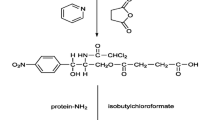Abstract
Antibodies specific for deoxynivalenol (DON) were prepared by immunizing rabbits with a deoxynivalenol-hemiglutaryl-HSA conjugate. The antibody showed cross-reactivity with DON, 15a-acetyl-DON (15-Ac DON), and 3a-acotyl-DON (3-Ac DON) of 100%, 216%, and 260%, respectively. No cross-reactivity was observed against 20 further trichothecenes of the A-, B-, and C-type. An indirect competitive ELISA procedure was set up for the detection of DON in liquid matrices occurring in the brewing process, Including beer. ELISA was sensitive down to 3.8 ng/mL. Detection limit for DON in tenfold diluted beer was 50 ppb. Recovery of the toxin in spiked beer was 45%, 77%, and 83% at toxin levels of 50; 500; and 1,000 ppb, respectively. ELISA results corresponded quite well with HPLC data. 196 commercial beers from several German breweries, including 36 gushing-positive samples, were assayed for DON. Screening revealed toxin levels from not detectable to 569 ppb. 69% of the gushing beers had marked levels of DON. 37% of the gushing-negative beer samples contained DON in detectable amounts with a maximum content of 172 ppb. Wheat beers had significantly higher DON-contents than beers derived from barley. Concentration of the toxin was significantly higher in gushing beers than in nongushing beers from both cereal sources.
Similar content being viewed by others
References
Amaha M, Kitabatake K (1981) Gushing in beer.In: Pollock JRA (Ed) Brewing science Vol 2, Academic Press, London, pp 457–489
Gjertsen P, Trolle B, Anderson K (1963) Wheatered barley as a contributory cause of gushing in beer.In: Proc EBC Congr, Brussels. pp 320–341
Prentice N, Sloey W (1960) Studies on barley microflora of possible importance to malting and brewing quality. I. The treatment of barley during malting with selected microorganisms. Proc Am Soc Brew Chem. pp 28–33
Gyllang H, Sätmark L, Martinson E (1977) The influence of some fungi on malt quality. Proc EBC Congr, Amsterdam, pp 251–258
Guggenberger J (1962) Über den Mechanismus des Wildwerdens von Bier. Proc EBC Congr, Brussels. pp 299–317
Gardner RJ (1973) The mechanisms of gushing — A review. J Inst Brew 79:275–283
Amaha M Kitabatake K, Nakagawa A, Yoshida J, Harada T (1973) Gushing inducers produced by some mould strains. Proc EBC Congr, Salzburg, pp 381–398
Kitabatake K (1978) A wort component responsible for gushing in beer. Bull Brew Sci. 24:21–32
Gjertsen P, Trolle B, Anderson K (1965) Studies on gushing. II Gushing caused by microorganisms, speciallyFusarium species. Proc EBC Congr, Stockholm, pp 428–438
Haikara A (1980) Gushing induced by fungi.In: European Brewery Convention, Monograph VI — Relationships between malt and beer. EBC. pp 251–258
Haikara A (1983) Malt and beer from barley artificially contaminated withFusarium in the field. Proc EBC Congr, London, pp 401–408
Niessen L, Donhauser S, Weideneder A, Geiger E, Vogel H (1992) Mykologische Untersuchungen an Cerealien und Malzen im Zusammenhang mit dem Wildwerden (Gushing) des Bieres. Brauwelt 132:702–714
Payen J, Girard T, Gaillardin M, Lafont P (1983) Sur la présence de mycotoxines dans des bières. Microbio Alim Nutr 1:143–146
Trucksess MW, Flood MT, Page SW (1986) Thin layer chromatographic determination of deoxynivalenol in processed grain products. J Assoc Off Anal Chem 69:35–36
Woller R, Majerus P (1982) Zur Mykotoxin- und insbesondere Aflatoxinsituation bei Bier, Ausgangsstoffen und Nebenprodukten der Bierbereitung. Monatsschr Brauwiss 35:88–90
Majerus P, Woller R (1983) Zur Mykotoxin-Situation bei Bier. 2. Mitteilung: Ochratoxin A und Citrinin. Monatsschr Brauwiss 36:335–336
Vecchio A, Finoli C, Peccedi M, Cerrutti G (1985) Sull’origine e la presenza di micotossine nella birra. Technol Alim 8:84–87
Cerrutti G, Vecchio A, Finoli C, Trezzi A (1987) Indices of quality enza di micotossine nella birra. Monatsschr Brauwiss 40:455–457
Tressl R, Hommel E, Helak B (1989) Bestimmung von Ochratoxin A in Gerste, Malz und Bier durch Hochdruckflüssigkeitschromato-graphie/Fluoreszenzdetektion. Monatsschr Brauwiss 42:331–335
Fukal L, Prosek J, Rakosova A (1990) Radiochemische Aflatoxin-bestimmung in Gerste, Malz und Bier. Monatsschr Brauwiss 43:212–215
Lepschy-von Gleissenthall J, Dietrich R, Märtlbauer E, Schuster M, Süß A, Terplan G (1989) A survey on the occurrence ofFusarium
Lepschy-von Gleissenthall J (1992) Analytik und Vorkommen von Deoxynivalenol. 14. Mykotoxin-Workshop, Gießen, 26.05.1992
Niessen L, Vogel H, Donhauser S (1993) Fate of deoxynivalenol (DON) in the brewing process. Monatsschr Brauwiss (in preparation)
Kamimura H, Nishijima M, Saito K, Yasuda K, Ibe A, Nagayama T, Ushiyama H, Naoi Y (1979) The decomposition of trichothecene mycotoxins during food processing (Studies on mycotoxins in foods. XII). J Food Hyg Soc Jpn 20:352–357
Scott PM, Kanhere SR, Daley EF, Farber JM (1992) Fermentation of wort containing deoxynivalenol and zearalenone. Mycotox Res 8:58–66
Casale WL, Pestka JJ, Hart LP (1988) Enzyme-linked immunosorbent assay employing monoclonal antibody specific for deoxynivalenol (vomitoxin) and several analogues. J Agric Food Chem 36:663 -668
Bauminger S, Wilchek M (1980) The use of carbodiimides in the preparation of immunizing conjugates. Meth Enzymol 70:151–159
Subba Rao PV, McCartney-Francis NL, Metcalfe DD (1983) An avidin-biotin micro-ELISA for rapid measurement of total allergen-specific human IgG. J Immunol Methods 57:71–85
Lauren DR, Greenhalgh R (1987) Simultaneous analysis of nivalenol and deoxynivalenol in cereals by liquid chromatography. J Asoc Off Anal Chem 70:479–483
Tanaka T, Hasegawa A, Yamamoto S, Lee U-S, Sjgiura Y, Ueno Y (1988) World wide contamination of cereals byFusarium mycotoxins nivalenol, deoxynivalenol, and zearalenone. 1. Survey of 19 countries. J Agric Food Chem 36:979–983
Donhauser S, Weideneder A, Winnewisser W, Geiger E (1989) Beurteilung von Malz als Ursache der Gushingneigung von Bier. Brauwelt 129:1658–1662
Niessen L (1993) Entwicklung und Anwendung immunchemischer Verfahren zum Nachweis wichtiger Fusarium-Toxine bei der Bierbereitung sowie mykologische Untersuchungen im Zusammenhang mit dem Wildwerden (Gushing) von Bieren. München, Technische Universität, Diss
Author information
Authors and Affiliations
Rights and permissions
About this article
Cite this article
Niessen, L., Böhm-Schrami, M., Vogel, H. et al. Deoxynivalenol in commercial beer — screening for the toxin with an indirect competitive ELISA. Mycotox Res 9, 99–109 (1993). https://doi.org/10.1007/BF03192241
Received:
Accepted:
Issue Date:
DOI: https://doi.org/10.1007/BF03192241




